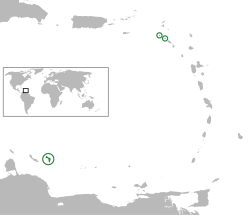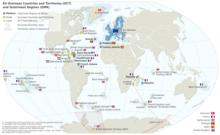

Caribbean Netherlands
Caribisch Nederland (Dutch)
| |
|---|---|
Overseas region of the Netherlands
| |
|
| |
| Anthem: "Wilhelmus van Nassouwe" (Dutch) (English: "William of Nassau")
| |

Location of the Caribbean Netherlands (green and circled). From left to right: Bonaire, Saba, and Sint Eustatius
| |
| Country | Netherlands |
| Special municipalities |
|
| Incorporated into the Netherlands | 10 October 2010 (dissolution of the Netherlands Antilles) |
| Official languages | Dutch |
| Recognised regional languages |
|
| Government | |
• Monarch | Willem-Alexander |
| |
• National Rep. | Jan Helmond |
| Area | |
• Total
| 322[3] km2 (124 sq mi) |
| Highest elevation | 887 m (2,910 ft) |
| Population | |
• 2022 estimate
| 27,726[4] |
• Density
| 77/km2 (199.4/sq mi) |
| Time zone | UTC−4 (AST) |
| ISO 3166 code | BQ, NL-BQ1, NL-BQ2, NL-BQ3 |
| Currency | United States dollar ($) (USD)[5] |
| Internet TLD |
|
The Caribbean Netherlands[8] (Dutch: Caribisch Nederland, pronounced [kaˈribisˌnedərˌlɑnt] ⓘ) is a geographic region of the Netherlands located outside of Europe, in the Caribbean, consisting of three special municipalities.[8] These are the islands of Bonaire, Sint Eustatius and Saba,[9][nb 1] as they are also known in legislation, or the BES islands (anacronym of their names) for short. The islands are officially classified as public bodies[10] in the Netherlands and as overseas territories of the European Union; as such, European Union law does not automatically apply to them.
Bonaire (including the islet of Klein Bonaire) is one of the Leeward Antilles and is located close to the coast of Venezuela. Sint Eustatius and Saba are in the main Lesser Antilles group and are located south of Sint Maarten and northwest of Saint Kitts and Nevis. The Caribbean Netherlands, which should not be confused with the more comprehensive Dutch Caribbean, has a population of 25,157 as of January 2019.[3]
The three islands gained their current status following the dissolution of the Netherlands Antilles on 10 October 2010.[11] At the same time, the islands of Curaçao and Sint Maarten became autonomous countries (Dutch: landen) within the Kingdom of the Netherlands.[12] The island of Aruba is also a constituent country of the Kingdom located in the Caribbean. The term "Dutch Caribbean" may refer to the three special municipalities (e.g. for stamps), but may also refer to all of the Caribbean islands within the Kingdom of the Netherlands. The population of the Caribbean Netherlands is 26,706.[13][14] Their total area is 328 square kilometres (127 sq mi). These figures are not consistent with the table below.
In 2012, the islands of the Caribbean Netherlands voted for the first time, due to being special municipalities of the Kingdom of the Netherlands, in the 2012 Dutch general election.[15]
The special municipalities (Dutch: bijzondere gemeenten) carry many of the functions normally performed by Dutch municipalities. The executive power rests with the Governing Council headed by an Island governor. The main democratic body is the island council. Dutch citizens of these three islands are entitled to vote in Dutch national elections and (as all Dutch nationals) in European elections.
Officially the islands are classed in Dutch law as being openbare lichamen (literally translated as "public bodies") and not gemeenten (municipalities). Unlike normal municipalities, they do not form part of a Dutch province[16] and the powers normally exercised by provincial councils within municipalities are divided between the island governments themselves and the central government by means of the National Office for the Caribbean Netherlands. For this reason, they are called "special" municipalities.
Many Dutch laws make special provisions for the Caribbean Netherlands.[17] For example, social security is not on the same level as it is in the European Netherlands.[18]
| Flag | Name | Capital | Area[3] | Population[19] (January 2022) |
Density |
|---|---|---|---|---|---|
| Bonaire | 288 km2 (111 sq mi) | 22,573 | 69/km2 (180/sq mi) | ||
| Sint Eustatius | 21 km2 (8.1 sq mi) | 3,242 | 150/km2 (390/sq mi) | ||
| Saba | 13 km2 (5.0 sq mi) | 1,911 | 148/km2 (380/sq mi) | ||
| Total | 322 km2 (124 sq mi) | 27,726 | 77/km2 (200/sq mi) | ||

The National Office for the Caribbean Netherlands (Dutch: Rijksdienst Caribisch Nederland) is responsible for taxation, policing, immigration, transport infrastructure, health, education, and social security in the islands and provides these services on behalf of the Government of the Netherlands.[20] This agency was established as the Regional Service Center in 2008 and became the National Office for the Caribbean Netherlands on 1 September 2010.[21][22] The current director is Jan Helmond.[23] The Representative for the public bodies of Bonaire, Sint Eustatius and Saba represents the Government of the Netherlands on the islands and also performs tasks similar to a King's Commissioner.[citation needed] The current representative is Gilbert Isabella.[24]

The islands do not form part of the European Union and instead constitute "overseas countries and territories" (OCT status) of the Union, to which special provisions apply.[nb 2] The Lisbon Treaty introduced a procedure where the European Council may change the status of an overseas territory of Denmark, France, or the Netherlands regarding the application of the EU treaties to that territory.[nb 3] In June 2008, the Dutch government published a survey of the legal and economic impacts by a switched status from OCT to outermost region (OMR).[25][26] The position of the islands was reviewed after a five-year transitional period, which began with the dissolution of the Netherlands Antilles in October 2010.[27] The review was conducted as part of the planned review of the Dutch "Act for the public bodies Bonaire, Sint Eustatius and Saba" (Dutch: "Wet openbare lichamen Bonaire, Sint Eustatius en Saba (WolBES)"), where the islands have been granted the option to become an OMR – and thus a direct part of the European Union.[28] In October 2015, the review concluded the present legal structures for governance and integration with European Netherlands was not working well within the framework of WolBES, but no recommendations were made in regards of whether a switch from OCT to OMR status would help improve this situation.[29][30][31][32]
The Kingdom of the Netherlands has overarching responsibility for foreign relations, defence and Dutch nationality law in the Caribbean parts of the Kingdom.[33] Units of the Netherlands Armed Forces deployed in the Caribbean include:
Additionally, the Dutch Caribbean Coast Guard is funded by the four countries of the Kingdom of the Netherlands. The Coast Guard is managed by the Ministry of Defence and is directed by the commander of the Royal Netherlands Navy in the Caribbean.[36]
The Caribbean Netherlands form part of the Lesser Antilles. Within this island group:
The islands of the Caribbean Netherlands enjoy a tropical climate with warm weather all year round. The Leeward Antilles are warmer and drier than the Windward islands. In summer, the Windward Islands can be subject to hurricanes.
Until 1 January 2011, the three islands used the Netherlands Antillean guilder; after that all three switched to the U.S. dollar, rather than the euro (which is used in the European Netherlands) or the Caribbean guilder (which is being adopted by the other two former Antillean islands of Curaçao and Sint Maarten).[37]
The telephone country code remains 599, that of the former Netherlands Antilles, and is shared with Curaçao. The International Organization for Standardization has assigned the ISO 3166-1 alpha-2 country code ISO 3166-2:BQ for these islands.[38] The IANA has not established a root zone for the .bq Internet ccTLD and whether it will be used is unknown.
Bonaire, Sint Eustatius and Saba are special municipalities. They are referred to as the Caribbean Netherlands.
... while the other islands, Bonaire, St. Eustatius, and Saba, are Dutch overseas public bodies and as such are part of the country of the Netherlands. Collectively these three islands are known as the Caribbean Netherlands ...
De openbare lichamen vallen rechtstreeks onder het Rijk omdat zij geen deel uitmaken van een provincie. (The public bodies (...), because they are not part of a Province).
|
| |||||
|---|---|---|---|---|---|
| |||||
| West Indies |
| ||||
| Caribbean Sea |
| ||||
| Caribbean continental zone |
| ||||
| Wider groupings may include: |
| ||||
N.B.: Territories in italics are parts of transregional sovereign states or non-sovereign dependencies. ^These three form the SSS islands that with the ABC islands comprise the Dutch Caribbean, of which *the BES islands are not direct Kingdom constituents but subsumed with the country of the Netherlands. †Physiographically, these continental islands are not part of the volcanic Windward Islands arc, although sometimes grouped with them culturally and politically. ǂDisputed territories administered by Guyana. ~Disputed territories administered by Colombia. #Bermuda is an isolated North Atlantic oceanic island, physiographically not part of the Lucayan Archipelago, Antilles, Caribbean Sea nor North American continental nor South American continental islands. It is grouped with the Northern American region, but occasionally also with the Caribbean region culturally. | |||||
|
Caribbean articles
| |||||||
|---|---|---|---|---|---|---|---|
| History |
| ||||||
| Geography |
| ||||||
| Politics |
| ||||||
| Economy |
| ||||||
| Culture |
| ||||||
|
| |||||||||||||
|---|---|---|---|---|---|---|---|---|---|---|---|---|---|
| Sovereign states |
| ||||||||||||
| Dependencies |
| ||||||||||||
|
Outlying territories of European countries
| |
|---|---|
Territories under European sovereignty but closer to or on continents other than Europe (see inclusion criteria for further information). | |
| Denmark |
|
| France |
|
| Netherlands |
|
| Norway |
|
| Portugal |
|
| Spain |
|
| United Kingdom |
|
| International |
|
|---|---|
| Geographic |
|